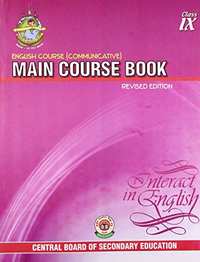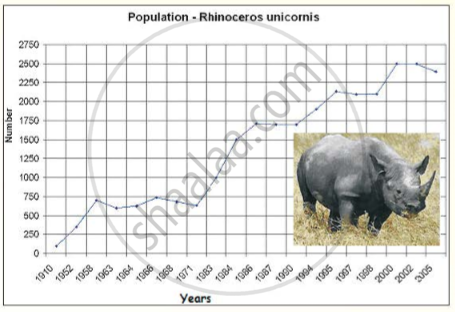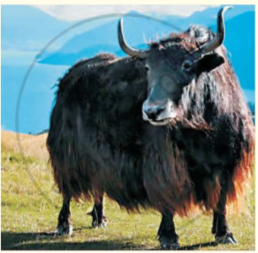Advertisements
Chapters
1.2: A Burglary Attempt
1.3: Can You Know People You Haven't Met
2.1: The Final Flight
2.2: The Sound of the Shell
2.3: Ordeal in the Ocean
▶ 3.1: The Indian Rhinoceros
3.2: Save Mother Earth
3.3: Save the Tiger
4.1: Radio Show
Chapter 4.2: Video Show
5.1: Bermuda Triangle
5.2: The Invisible Man
5.3: The Tragedy of Birlstone
5.4: Harry Potter
6.1: Tom Sawyer
6.2: Children of India
6.3: Children of Computer
6.4: Life Skills
6.5: We are the World
7.1: Grandmaster Koneru Humpy Queen of 64 Squares
7.2: It's Sports Day
7.3: Hockey and Foodball

Advertisements
Solutions for Chapter 3.1: The Indian Rhinoceros
Below listed, you can find solutions for Chapter 3.1 of CBSE CBSE for English Communicative - Main Course Book Interact in English Class 9.
CBSE solutions for English Communicative - Main Course Book Interact in English Class 9 3.1 The Indian Rhinoceros Exercise [Pages 46 - 53]
The Indian Rhinoceros: Where are they? Do they have a future?
We are very materialistic and are often lured into buying and using clothes and articles made from animal skin and other organs.
Here's a shopping list ....... .

The list seems endless, doesn't it? Are these things not shameful enough to set us pondering deeply over the harm that we are inflicting on nature's creations?
1. Why is the list 'most shameful'?
2. What is the name of the organisation that has been formed to protect and conserve wildlife?
3. Name at least ten other animals that are being exploited by man for commercial purposes. Surf the net to get your information and complete the following table
| Animal | Part of the body used | Product |
| 1. | ||
| 2. | ||
| 3. | ||
| 4. | ||
| 5. | ||
| 6. | ||
| 7. | ||
| 8. | ||
| 9. | ||
| 10. |
Read this article about the great Indian Rhinoceros. [You will find the information useful for your group discussion in 5.]
The Indian Rhinoceros or the Great One-Horned Rhinoceros or the Asian Onehorned Rhinoceros (Rhinoceros unicomis) is a large mammal primarily found in north-eastern India, Nepal and parts of Bhutan. It is confined to the tall grasslands and forests in the foothills of the Himalayas.
The Indian Rhinoceros once ranged throughout the entire stretch of the Indo Gangetic Plain but excessive hunting reduced their natural habitat drastically.
Today, about 3,000 Indian Rhinos live in the wild, 1,800 of which are found in Assam alone. In 2008, more than 400 Indian Rhinos were sighted in Nepal's Chitwan National Park.
In size it is equal to that of the White Rhino in Africa; together they are the largest of all rhino species. The Great One-Horned Rhinoceros has a single horn; this is present in both males and females, but not on newborn young. In most adults, the horn reachee a length of about 25 centimetres, but has been recorded up to 57 .2 centimetres in length. The nasal hom curves backwards from the nose. The horn is naturally black.
This prehistoric-looking rhinoceros bas thick, silver-brown skin which becomes pinkish near the large skin folds that cover its body. The male develops thick neckfolds. It has very little body hair aside from eyelashes, ear-fringes and tail-brush.
These rhinos live in tall grasslands and riverine forests, but due to the loss of habitat, they have been forced towards cultivated land. They are mostly solitary creatures, with the exception of mothers and calves and breeding pairs, although they sometimes, congregate at bathing areas.

The Indian Rhinoceros makes a wide variety of vocalizations. At least ten distinct vocalizations have been identified: snorting, honking, bleating, roaring, squeak panting, moo-grunting, shrieking, groaning, rumbling and humphing. In addition to noises, the rhino also uses olfactory communication.
In aggregation, Indian Rhinos are often friendly. They will often greet each other by waving or bobbing their heads, mounting flanks, nuzzling noses, or licking. Rhinos will playfully spar, run around, and play with twigs in their mouth. Adult males are the primary instigators of fights. Fights between dominant males are the most common cause of rhino mortality. Indian rhinos have few natural enemies, except for tigers. Tigers sometimes kill unguarded calves, but adult rhinos are less vulnerable due to their size. Humans are the only other animal threat, hunting the rhinoceros primarily for sport or for the use of its horn. Indian Rhinos have been somewhat tamed and trained in circuses, but they remain dangerous and unpredictable animals.
In the nineteenth and early twentieth century, the Indian Rhinoceros was hunted relentlessly. Reports from the middle of the nineteenth century claim that some military officers in Assam individually shot more than 200 rhinos. In the early 1900s, officials became concerned at the rhinos' plummeting numbers. By 1908 in Kaziranga, one of the Rhinos' main ranges, the population had fallen to around 12 individuals. In 1910, all rhino hunting in India became prohibited.
The rhino has been a major success in conservation. Only 100 remained in the early 1900s; a century later, their population has increased to about 2500 again, but even so, the species is still endangered. The Indian rhino is illegally poached for its horn. Some cultures in East Asia believe that the hair has healing and potency powers and therefore is used for traditional Chinese medicine and other Oriental medicines.
The Indian and Nepalese Governments have taken major steps towards Indian Rhinoceros conservation with the help of the World Wildlife Fund (WWF). The Kaziranga National Park and Manas National Park in Assam, Pobitora Reserve Forest in Assam {having the highest Indian rhino density in the world), Orang National Park of Assam, Laokhowa Reserve Forest of Assam (having a very small population) and Royal Chitwan National Park in Nepal are homes to this endangered animal.
In Units 1 and 2 you learnt and practised the skill of deducing the meanings of new words by using other words in the given context. Now use that skill to deduce the meanings of words in the article you have read. Here is an example.
(a) They are solitary creatures with the exception of the mothers and calves and breeding pairs, although they sometimes congregate at bathing places.

Deduce the meanings of the following words from the passage you have just read, using other words in the context to help you. Copy and complete the following :
| Word | Words/clues that helped me | what I think the word means | what the dictionary says | were you (✓) (tick mark) or (x) |
| confined | ||||
| ranged | ||||
| overlapping | ||||
| bobbing | ||||
| olfactory | ||||
| aggregation | ||||
| plummeting | ||||
| mortality | ||||
| vulnerable | ||||
| poached |
Punctuate the Following:
the indian rhinoceros was the first rhinoceros known to europeans rhinoceros comes from the greek rhino meaning nose and ceros meaning horn the indian rhinoceros is monotypic there are no distinct subspecies rhinoceros unicornis was the type species for the rhinoceros family first classified by carolus linnaeus in 1758 the indian rhinoceros was the first rhino widely known outside its range the first rhino to reach europe in modern times arrived in lisbon in may 20, 1515 king manuel I of portugal planned to send the rhinoceros to pope leo x but the rhino perished in a shipwreck.
Imagine that you are conducting a research on the conservation of a few animal species in India. You have been asked by the Wildlife Trust of India to prepare a report on the future of the YAK that lives in the Ladakh region of the Himalayan mountains . In groups of four, discuss the issue and make notes for your report. Refer to the Question 2 and the information in the box given here.

| DOMESTIC YAK |
| herd animals 2-2.2 m tall |
| used in sports |
| kept for milk , fur , fibre , meat , drawing ploughs etc |

| WILD YAK |
| length:3-3. 4m |
|
habitat: treeless uplands
|
| killed for food |
| insulated from cold by dense, close matted under hair , shaggy outer hair |
| hunted for similar reasons as the domestic ones |
Within your group, discuss
• What is the problem? How has it arisen?
• What is the best way to preserve these species?
• Why do we need to preserve these species?
• What values need to be inculcated in the hearts of human beings? Why?
• What actions would you recommend to the World Wildlife Federation?
• How is global warming affecting these species?
During your discussions in groups, and in your individual written report, you will find the following language useful :
GROUP DISCUSSION
When recommending
| I | Propose suggest recommend |
that..... |
| what about ? why don't we....... |
| we could think |
consider...... about......... |
WRITTEN REPORT
When recommending
| I |
propose |
that..... |
| I strongly recommend that ........ |
| I urge the commision to ....... |
| It is | recommended proposed |
that.... |
| My | recommendation proposal |
is that...... |
When giving reasons
| ................. as .............. ................because ......... ..............since ............... |
| My reason is that .................... |
When giving reasons
| ................. as .............. ................because ......... ..............since ............... |
| My reason is that....................... In view of the fact that.............. |
As a Conservationist, write a report to the World Wildlife Federation, based on 5. Remember 'CODER'
| From: (your name), Conservationist. To: The Chairman WWF (Date) (Suitable Heading) (Suitable introduction) e.g. You recently asked me to submit a report on my study of YAK - in particular, their future. The following are my findings and recommendations. 1. The current problem. 2. Reasons why this problem has arisen. 3. Effects of the problem 4. Recommendation 5. Conclusion (Suitable ending, including other ideas for increasing YAK population) Your name (Conservationist) |
Solutions for 3.1: The Indian Rhinoceros

CBSE solutions for English Communicative - Main Course Book Interact in English Class 9 chapter 3.1 - The Indian Rhinoceros
Shaalaa.com has the CBSE Mathematics English Communicative - Main Course Book Interact in English Class 9 CBSE solutions in a manner that help students grasp basic concepts better and faster. The detailed, step-by-step solutions will help you understand the concepts better and clarify any confusion. CBSE solutions for Mathematics English Communicative - Main Course Book Interact in English Class 9 CBSE 3.1 (The Indian Rhinoceros) include all questions with answers and detailed explanations. This will clear students' doubts about questions and improve their application skills while preparing for board exams.
Further, we at Shaalaa.com provide such solutions so students can prepare for written exams. CBSE textbook solutions can be a core help for self-study and provide excellent self-help guidance for students.
Concepts covered in English Communicative - Main Course Book Interact in English Class 9 chapter 3.1 The Indian Rhinoceros are Reading, Writing and Grammar, Literature Textbook and Extended Reading Text.
Using CBSE English Communicative - Main Course Book Interact in English Class 9 solutions The Indian Rhinoceros exercise by students is an easy way to prepare for the exams, as they involve solutions arranged chapter-wise and also page-wise. The questions involved in CBSE Solutions are essential questions that can be asked in the final exam. Maximum CBSE English Communicative - Main Course Book Interact in English Class 9 students prefer CBSE Textbook Solutions to score more in exams.
Get the free view of Chapter 3.1, The Indian Rhinoceros English Communicative - Main Course Book Interact in English Class 9 additional questions for Mathematics English Communicative - Main Course Book Interact in English Class 9 CBSE, and you can use Shaalaa.com to keep it handy for your exam preparation.
